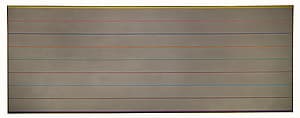

Kenneth Noland
Learn moreOakum 1970
© Kenneth Noland. VAGA/Copyright Agency Purchased 1973
More detail | PermalinkKenneth Noland had his first solo exhibition at the Galerie Raymond Creuze, Paris, in 1949, after moving there to study with sculptor Ossip Zadkine in 1948. Noland returned to the United States soon afterwards, settling in Washington DC and teaching at the Institute of Contemporary Art. While teaching evening classes at the Washington Workshop Center of the Arts in 1952 Noland met Morris Louis. The two artists visited New York in 1953 and were impressed by the stain techniques developed by Helen Frankenthaler, and both Noland and Louis began applying these after they returned to Washington.
In 1958 Noland began working on his ‘targets’, paintings based on concentric rings of colour. During the early 1960s he participated in a number of important group exhibitions that brought together artists working in a style of hard-edge and stained colour-field abstraction. Noland also made sculptures and was a prolific printmaker.
Between 1967 and 1970 Noland worked on a body of horizontally-striped rectangular paintings, completing over 200 of them.[1] He began using this format earlier, while still exploring the variations in his series of diamond-shaped canvases from 1964–67. These early horizontal striped paintings were long and thin, loosely painted with the brush. By the time this type of painting became Noland’s main concern, in 1967, he took on assistants for the first time and began using masking tape to give precision to the stripes. The usual procedure was to staple a length of canvas to the floor, paint the stripes using tape to guide the edges of each line, then crop the canvas to an appropriate size. By 1967 the paintings had become wider; often the stripes were arranged around bare canvas. The colours were varied in the early stripes but tended to be restricted in the works after 1968.
Made in 1970 in the artist's studio at South Shaftsbury, Vermont, Oakum was one of the last of this series of paintings. In an interview in 1971 Noland mentioned that he liked ‘that edge between water and land’,[2] something that plants the notion of landscape into his horizontal stripe paintings; the title Oakum refers to the compound of loose fibre made of old rope used in caulking the planking of boats.
Michael Lloyd and Michael Desmond[3]
[1] Kenworth Moffett, Kenneth Noland, Harry N Abrams, New York, 1977, p 72.
[2] From an interview with Kenneth Noland by Paul Cummings, 1971, quoted in part in Diane Waldman, Kenneth Noland: A retrospective, Solomon R Guggenheim Museum, New York, 1977, p 33.
[3] Adapted and updated from Michael Lloyd and Michael Desmond, European and American Paintings and Sculptures 1870–1970 in the Australian National Gallery, Australian National Gallery, Canberra, 1992, p 422, by Steven Tonkin.

